The future urban-modular

[Image: An architectural "super-prosthesis" by Santiago Cirugeda Parejo].
Quite a while back I got an email from Wes Janz, who runs something called onesmallproject, a fascinating look at standards of housing and urbanism – including the absence of the former – around the world. What does home look like elsewhere? How do people find shelter? Are we perhaps approaching a planetary urbanism? Etc.
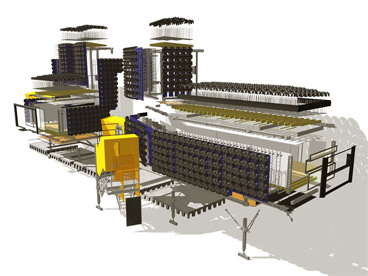
Arguably, this would all begin a series of questions that could lead back to Heidegger; for instance: is architecture an appropriate response for those who dwell in a state of homelessness – Heidegger's state of "harassed unrest"? Is dwelling always an architectural activity? What of "those buildings that are not dwelling places" – or those dwelling places that are not buildings? And so on.
In any case, here are some statistics from the project's facts pages to consider:
• by 2030, 1 person in 4 will be a slum dweller
• every day, 200,000 people move to cities worldwide (which is 73 million people urbanizing every year)
• half the population of Istanbul lives in slums
• Caracas has 5 police forces, wearing 5 different uniforms
• 10-30% of U.S. waste comes from architectural demolition and construction
Where it gets interesting, however, is in offering solutions, proposing something, offering ideas. Everyone knows how to complain; imaginative responses are welcome for their sheer infrequency.
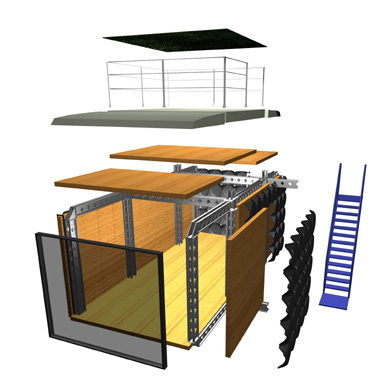
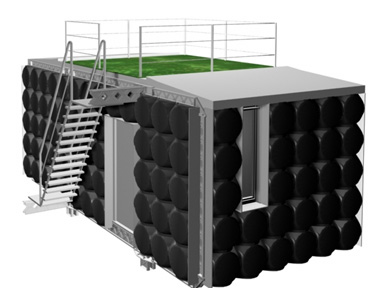
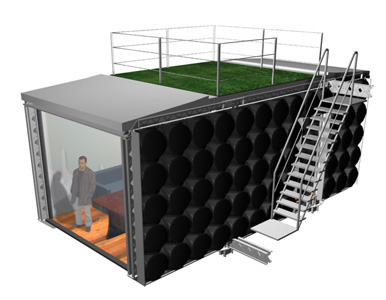
The images I'm showing, for instance, are by Santiago Cirugeda Parejo, a member of onesmallproject, taken from Parejo's own website.
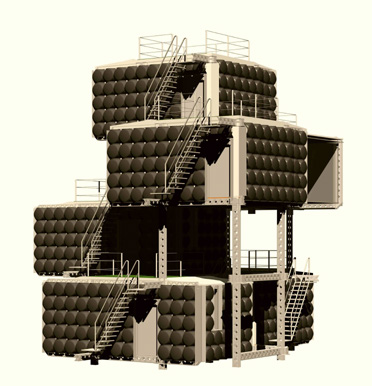
Parejo's work explores a kind of do-it-yourself tactical urbanism, using modular frame structures and prefabricated building units in a way that "exploits gaps in administrative structures, governmental bodies’ supervisory energies, official procedures, and where the law falls short." In the process, Parejo transforms vacant lots and peripheral spaces into what he calls "subversive urban occupations."
This has included working with scaffolding: constructing nest-like "urban reserves" in the spaces defined by construction scaffolds, enlarging houses parasitically.
The architectural prosthesis, in fact, is something Parejo frequently explores by constructing temporary, unofficial extensions to existing buildings – including this capsule on stilts, "installed orthopaedically... as a spatial and functional prosthesis," in a place called the Finland Pavilion.
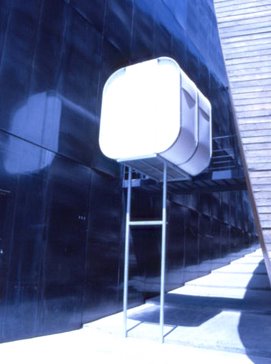
There is a lot more information – including dozens of projects – at both Parejo's site and at onesmallproject. Of course, as a side note, even as I write this a new exhibition continues apace at the NLA, called Prefabulous London.

There, you can gaze all you like at plans and photos of affordable, high-density urban construction techniques using prefabricated structures, including a few parasite-like microbuildings. If you're not sure you want to go, or live elsewhere – attempting to dwell while located otherwise – you can always download the exhibition's catalog here (1.8MB PDF); or click through some other coverage of the show at Inhabitat (who link to an interesting article in Building Design) or the London-based City of Sound.

Comments are moderated.
If it's not spam, it will appear here shortly!
Perhaps each piece of Parejo's design could be sold or distributed separately, like a prosthetic only replacing the missing part. Could squatters even make use of the surplus bits of architecture, extra doors, old windows, surplus siding, that are discarded as waste every day in the United States?
Such an approach might integrate more effectively with existing patterns of construction and development than importing whole structures prefabricated or otherwise. Consider,
"With no access to financial services due to the simple scarcity of legitimate banks and with marginal incomes to begin with people in these impoverished regions of the globe have had to devise means of acquiring housing without the crutch of bank finance. Ways of saving for a home without saving money. Their solution is straightforward. I understand that, when it's not practical to borrow or save money for a home and there are no suitable natural home-building materials at-hand, people in many Third World communities -particularly in desert regions- simply stockpile building materials, saving for a home by literally saving up what it's made from over time... Building materials are traded like money and in some cases they may form the basis of dowries and inheritances. Consequently, the most popular building materials in these regions of the world are those which are weather resistant, come in simple modular forms, and can be purchased or traded for in small volume. Things like clay and concrete block and corrugated steel sheet."
http://radio.weblogs.com/0119080/stories/2003/03/11/galleryUrbanNomadics.html
Hey Eli - I'm tempted to say that squatters already do put old architectural discards to use; though definitely not in the - perhaps more organized or even regulated - way you might be imagining. Instead of a soup kitchen, a kind of architectural parts bank, people lined up to receive new sheets of vinyl siding, hinges, 2x4s, nails...
I saw someone posted, maybe Regine on we make money not art - or Inhabitat - or Archinect - about using camera phones and local Frappr maps to let other people know where to dumpster-dive: say you find an intact computer desk being thrown away by your local university, but you don't need a desk - so you camera-phone it, upload the image, and anyone with access to the map (and with free time and a truck) could get the desk...
A less technology-centric and capital-intensive (transportation) version could set up an interesting kind of architecture bank right here in the city alongside everyone: putting the discard pile to use. Turning unused architectural excess into unofficial housing.
I was mostly thinking of a local organization we have in Pittsburgh, that I also know is very popular with folks in our squatter and sweat equity community.
Construction Junction
http://www.constructionjunction.org/
Only, in addition to old-sinks, stair cases, and lead-paint covered windows, I would love to see an avantgarde house being sold by bits and pieces.
Also, your African astronomy post was great! I can't wait to track down that documentary.
Post a Comment